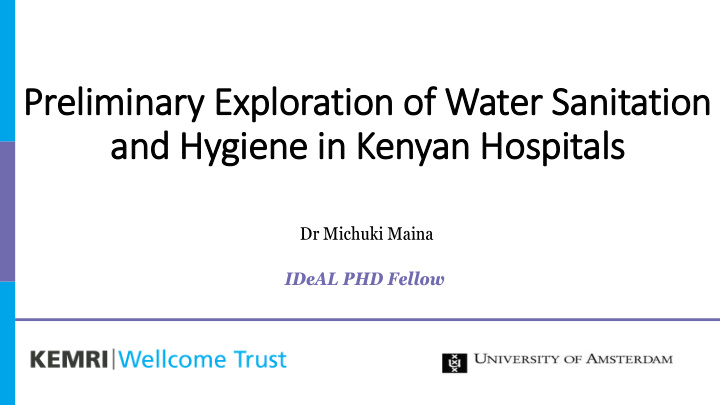



Preliminary ry Exploration of Water Sanitation and Hygiene in in Kenyan Hospitals Dr Michuki Maina IDeAL PHD Fellow
Background • Proper WASH structures are an integral part of infection prevention and control (IPC) in hospitals. • Improving WASH linked to specific benefits; • Reductions in hospital associated infections; • Reduction in antimicrobial resistance; • Reduction in health care costs. • WASH global report 2019 show that 1 in 4 health facilities do not have basic water services.
WASH FIT IT -Water, Sanitation and Hygiene in in Healthcare Facil ilities (H (HCFs) Im Improvement Tool • Developed in 2015. Has been piloted in a number of different countries and contexts; • Covers four broad domains: water, sanitation, hygiene and management; • Each domain includes indicators and targetsfor achieving minimum standardsfor maintaining a safe and clean environment ;
Objectives • Develop a survey tool that can be applied at national or sub-national level to monitor IPC service performance in hospitals. • To evaluate the IPC arrangements in Kenyan county hospitals and explore how these may vary within a single public health system.
Methods
Modification of WASH FIT IT Facility Improvement tool to a survey tool 1. Modified tool for ward and facility assessments. 2. Rearrange the indicators into new groups by level of health system accountability. 3. Develop a meaningful aggregate score grouped into different levels By hospital; by specialty; by accountability; by domain; and by indicator
Data collection • Data collected in 14 public hospitals in Kenya • The data collection team - nurses, medical officers, pharmacists. • Actual data collection included hospital representatives – IPC leads, Public health officers, nursing officers. • Interviews with hospital managers, frontline health workers. Data collection team
Results
Proposed WASH Categories Based on Responsibility Responsibility FACILITY BASED County/Regional INDICATORS Government * County 9 Government* Hospital 31 Hospital Management** Management Infection 25 Prevention and control Committee 65 Infection Prevention Committee **Medical director, Nursing officer in charge, chief administrative officer, hospital management board * This level may be different in other countries depending on governance structure
Hospital Level Performance
Ward Level Performance
Thematic areas fr from In Interviews • Challenges with the built environment • Resource availability and allocation • Leadership at hospital and ward level • I MPROVING W ASH – INSIGHTS FROM THE FIELD • Outsourcing – a solution for general cleanliness? • Improving personal and professional attitudes towards WASH and IPC • Training and orientation of all cadres of staff on WASH • Partnerships to improve WASH offer partial improvement in the sector
Conclusion • WASH is a Key pillar in improving infection prevention and control in hospitals • Significant differences and challenges exist in the state of WASH within and across hospitals. • Enhance accountability (leadership) and resources allocation to improve WASH
Acknowledgments Council of Governors
Key drivers and challenges in in im improvement of quality of care, , A case of Nyeri County Referral Hospital Dr. Pauline Kamau Pharmacist and Infection Prevention and Control Lead
Objectives • To highlight the best Infection Prevention and Control (IPC) practices at Nyeri County Referral Hospital (NCRH) in improvement of quality of care. • Highlight the challenges at NCRH that hinder optimal delivery of patient care .
Background: Nyeri County Referral Hospital • Formerly known as Nyeri Provincial General Hospital • Started in 1930- Military Hospital • Regional hospital level 5 Hospital • Bed capacity- 270 and 50 cots • Average bed occupancy-130% (Congestion) • Average daily Outpatient attendance-582 patients • Average daily In-patient admission-116 patients
Core issues in Im Improving In Infection Prevention and Control and WASH • Leadership and governance structure • Accountability • Shared responsibilities and roles • Education and capacity building • Monitoring and Evaluation
Leadership and governance structure • Multidisplinary constituted IPC Committee • Comprehensive Terms of reference • Formal appointment of the committee members • Dedicated and committed IPC focal person • Team of link persons from all departments
Accountability • Progress reports to the Hospital Management Team (HMT) • Collaboration with the Medicine and Therapeutics Committee (MTC) • Involvement in county forums e.g. County Antimicrobial Stewardship Interagency Committee
Shared Responsibilities and Roles • Development of an action plan • Prioritization of activities based on situational analysis • Development of chart on Hand Hygiene • Development of customized Health Care Waste Management policy
Monitoring and Surveillance • Hand Hygiene Compliance Audits • Weekly commodity audit • Ward infrastructure audit • Healthcare Associated Infection(HAI) surveillance audits
Awareness, , Training and Education • Routine On-job training of health workers and support staff. • Availability of the IECs materials in the clinical areas e.g. Hand Hygiene and Waste segregation posters • Sensitization of Health Care Workers on emerging issues e.g. Continuing Medical Education.
Challenges • Congested wards • Strained sanitary facilities for the patients • IPC activities are not part of performance appraisal of most of the staff • No action or recognition of performance in WASH/IPC activities • Lack of HAIs surveillance system
Recommendations • Budgetary allocation for WASH/IPC activities • Establishment of HAIs surveillance system • Continuous training on IPC
Thank you
Recommend
More recommend